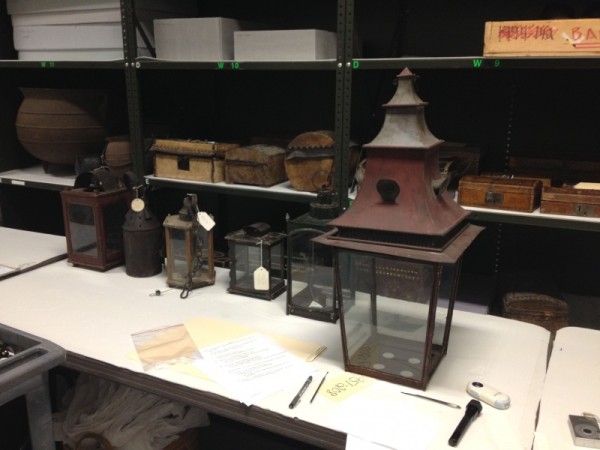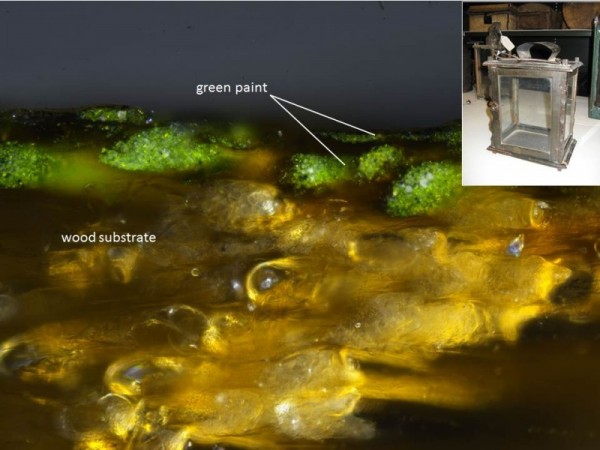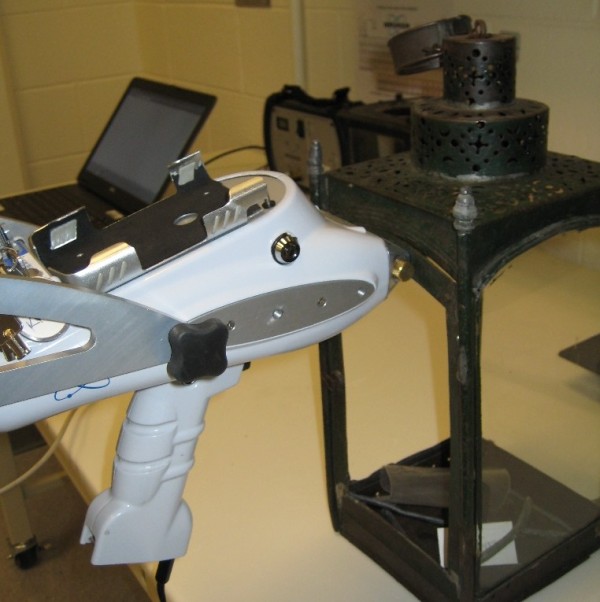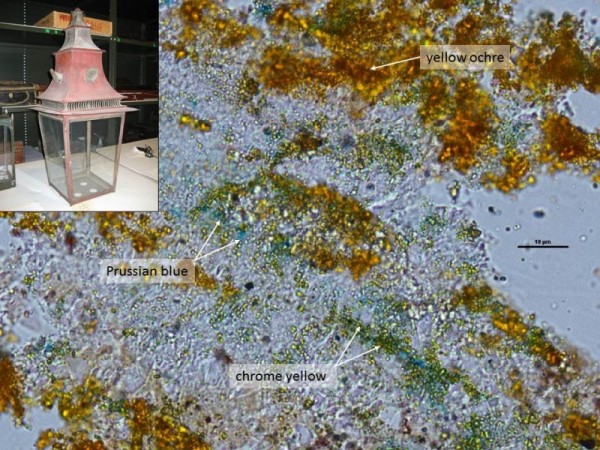
Lanterns from the CWF collection awaiting analysis
Hello and welcome to the first post of “Beneath the Surface”, the blog that keeps you up to date on the latest activities at Colonial Williamsburg’s Materials Analysis Laboratory, where the 18th century meets modern-day science. Here, we use sophisticated analytical instruments to better understand the art and artifacts that make up our varied collection.
I’m Kirsten Travers Moffitt, the Foundation’s first Materials Analyst (as well as Associate Conservator of Painted Objects), and I’ll be your guide.
I would like to start by sharing a current project that highlights the capabilities of the lab and the impact that analytical work can have in the historic area.
As some of you know, one of CW’s major projects right now is the reconstruction of the Market House. Many branches of CW have been involved with the research, planning, and construction of the site, and the tinsmiths have been working hard to craft period-appropriate lanterns to hang there.
Historically, many tin objects were painted for protection and decoration. In keeping with this treatment, the lanterns will be painted with hand-ground paints, but the question is: what color should they be painted? What pigments and binding media (for instance, a linseed oil or varnish) should be used?
This was a perfect project for the Materials Analysis Laboratory.
To help answer this question, I was asked to analyze the paints on several lanterns we have in our collection, dating from the 18th to the early 19th centuries. I examined each object carefully and collected small paint flakes from each with the help of a surgical scalpel. I prepared cross-sections of each paint sample and examined them under the microscope to see how many layers were present, and which was the original. This technique, called cross-section microscopy, allowed me to see other important characteristics such as the general color of each layer, the consistency and thickness of the paints, and the presence of dirt and wear at the surface- a dead giveaway for coatings that have been exposed for long periods of time.
And the winner is…Green! Most of the lanterns had green as their first paint color.

Cross-section photomicrograph of sample 1935-12_1 (inset), showing green paint on wood, reflected visible light, 200x
But the color was only one part of the mystery. What were these green paints made of? Other techniques in the lab were applied to answer this question.
I analyzed each lantern with our portable XRF (X-ray Fluorescence Spectrometer), an instrument that uses x-rays to analyze the elemental composition of a sample. Any element above sodium (Na) can be detected with this method, which is invaluable when characterizing pigments. For instance, the presence of mercury (Hg) and sulfur (S) in a red paint would strongly suggest that the red pigment vermilion (HgS) was present.

Performing XRF on lantern 1968-482
I also carried out polarized light microscopy (PLM) for pigment ID, which is a geological technique that allows one to observe the individual pigment particles and make identifications based on their optical properties such as color, morphology, and refractive index. Online databases and reference collections at CW were also used for comparison.
So far, the data indicates that all of the green paints were made with a combination of blue and yellow pigments, rather than a single green pigment alone.
All of the greens contained Prussian blue (Fe4[Fe(CN)3]3), a blue pigment with incredible tinting strength, introduced in 1704 and found in many 18th c. paints.
All of the paints also contained yellow ochre (Fe2O3 • nH2O), an iron oxide pigment collected from the earth. Colors range from browns and reds to oranges and yellows, and are what gives certain soils their distinctive colors. Ochres have been in use since antiquity because they are cheap, available, and very durable.

Dispersion of pigments from green paint on lantern 1951-208 (inset), transmitted plane polarized light, 1000x
But here’s where it gets complicated- some of the green paints also contained chrome yellow (PbCrO4), a bright yellow pigment that was not introduced until c.1810. This means that these paints post-date the 18th century.
Chrome yellow pigment will, of course, not be used in the paint replication, since it would not have been available during the colonial period.
So far, the findings suggest that the market house lanterns should be painted with a green paint made with Prussian blue and yellow ochre.
The next step is to analyze the binding media with FTIR (Fourier-transform infrared spectroscopy), a technique that uses infrared energy to identify organic materials such as resins, oils, and waxes. This should tell us if the pigments were ground in oil, or a varnish, or perhaps both.
I’ll continue to work with the lantern samples to learn all I can, and convey the findings to the tinsmiths so they can move forward with painting, and I’ll keep you posted on their progress.
Thanks for reading, and until next time…keep looking!
Does your analysis reveal the proportions of the blue and green pigments? Are their any available print references for artists or craftsmen by which they could mix their own paints that might identify likely “formulae” in case the analyses cannot?
I think this is grand, and adds much to my appreciation of Colonial Williamsburg’s endeavors. 🙂
Thanks for your comment, Tom! With enough samples for comparison I can provide a rough estimate of pigment proportions in a paint layer which can provide a general guide for replication. However, this is not an exact science because there are so many variations in pigment properties due to their manufacture or source that can change over time. We find it is often best to know the pigment composition and have a color swatch to match to.
There are a number of wonderful historic paint treatises that provide a wealth of information. A few examples that relate to architecture, furniture, coaches, and other utilitarian objects are:
John Smith. The Art of Painting in Oyl. First Edition 1676.
Pierre-Francois Tingry. 1804. The Painter and Varnisher’s Guide, or, a Treatise, both in Theory and Practice, on the Art of Making and Applying Varnishes, on the different kinds of Painting, and on the Method of Preparing Colours. London: Printed for G. Kearsley by J. Taylor.
Hezekiah Reynolds. Directions for House and Ship Painting. A Facsimile Reprint of the 1812 Edition with a New Introduction by Richard M. Candee. Worcester: American Antiquarian Society, 1978.
Potomacker says
According to the link: “Chrome yellow, which came on the market in early 1800s,…”
You seem very quick to eliminate this from the possible pigment options. “Early 1800s” is not exactly an absolute terminus post quem. It seems that if you want to stick with this date, then you might have discovered an earlier example of Chrome yellow than previously cited. Or else, it might simply eliminate that particular style of lantern from consideration as well as the strict limits limits placed on the pigment choices.
Thanks for bringing this up. I used the term “early 1800s” and I shouldn’t have. We do have a certain date of introduction for chrome yellow, which is 1814-15. Chrome as an element was only first discovered in 1797 by Louis Nicolas Vauquelin, who named it such due to the various hues that could be created from it. He was the first to prepare chrome yellow pigment (PbCrO4, or, lead chromate) by adding lead acetate or nitrate to potassium chromate. However, due to scarcity of the raw material, chrome yellow was not commercially available as an artist’s pigment until 1814. This date has been established through documentary research as well as technical studies of paintings and painted artifacts of known date.
Paul L. Brennan says
Will the paint eventually by prepared by Al Mitchell of the wheelwright shop?
Great question! Alan has prepared so many hand-ground paints for objects in our historic area. He tells me he has already made up a batch of greens (using Prussian blue and yellow ochre) that may be used as references for this project. I’ll see him next week to discuss.